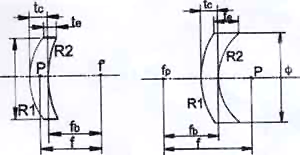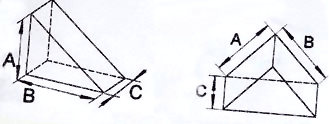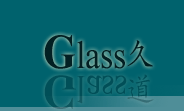Aspherical lens
An aspheric or asphere lens is a lens whose surfaces have a profile that is neither a portion of a sphere nor of a circular cylinder. The asphere's more complex surface profile can eliminate spherical aberration and reduce other optical aberrations compared to a simple lens. A single aspheric lens can often replace a much more complex multi-lens system. The resulting device is smaller and lighter, and possibly cheaper than the multi-lens design.
|
|
| |
| |
Plano convex lenses
Plano-convex lenses have a plane and a convex surface. it also has a positive focal length, which makes them ideal for collecting and focusing light , then these lenses are used for telescopes, magnifier, collimator, radiometer, transceiver, condensers etc.. |
|
|
Drawing |
| Diameter Tolerence: |
+0mm - 0.25mm |
|
| Edge/Centre Thickness Tolerence: |
+/- 0.25mm |
| Edge Finish: |
fine ground or beveled |
| Clear Aperture Diameter: |
80-90% of central diameter |
| Surface Figure: |
^/4 @ 632.8 nm |
| Surface Quality: |
60-40 scratch and dig |
| Bevel: |
0.25mm x 45 degree |
| Focal Length Tolerence: |
+/-2% |
| Back Focal Lenght Tolerence |
+/-2% |
|
| |
| |
Bi-convex lenses
Bi-convex lenses have a convex curve on both the incoming and outgoing surfaces. then these lenses have positive focal lengths and form both real and virtual images. |
|
|
Drawing |
| Diameter Tolerence: |
+0mm - 0.25mm |
|
| Edge/Centre Thickness Tolerence: |
+/- 0.25mm |
| Edge Finish: |
fine ground or beveled |
| Clear Aperture Diameter: |
80-90% of central diameter |
| Surface Figure: |
^/4 @ 632.8 nm |
| Surface Quality: |
60-40 scratch and dig |
| Bevel: |
0.25mm x 45 degree |
| Focal Length Tolerence: |
+/-2% |
| Back Focal Lenght Tolerence |
+/-2% |
|
| |
| |
Plano concave lenses
Plano-concave lenses have one flat side and one inward curved face and negative focal lentgth. They are used for image reduction or to spread light. |
|
|
Drawing |
| Diameter Tolerence: |
+0mm - 0.25mm |
|
| Edge/Centre Thickness Tolerence: |
+/- 0.25mm |
| Edge Finish: |
fine ground or beveled |
| Clear Aperture Diameter: |
80-90% of central diameter |
| Surface Figure: |
^/4 @ 632.8 nm |
| Surface Quality: |
60-40 scratch and dig |
| Bevel: |
0.25mm x 45 degree |
| Focal Length Tolerence: |
+/-2% |
| Back Focal Lenght Tolerence |
+/-2% |
|
| |
| |
Bi-concave lenses
Bi-concave lenses with both curved sides have negative focal length, and are used for image reduction and to spread light. |
|
|
Drawing |
| Diameter Tolerence: |
+0mm - 0.25mm |
|
| Edge/Centre Thickness Tolerence: |
+/- 0.25mm |
| Edge Finish: |
fine ground or beveled |
| Clear Aperture Diameter: |
80-90% of central diameter |
| Surface Figure: |
^/4 @ 632.8 nm |
| Surface Quality: |
60-40 scratch and dig |
| Bevel: |
0.25mm x 45 degree |
| Focal Length Tolerence: |
+/-2% |
| Back Focal Lenght Tolerence |
+/-2% |
|
| |
| |
Meniscus lenses
Meniscus lenses can increase the numerical aperture of a positive lens assembly, without an undue increase in the aberrations. |
|
|
Drawing |
| Diameter Tolerence: |
+0mm - 0.25mm |
 |
| Edge/Centre Thickness Tolerence: |
+/- 0.25mm |
| Edge Finish: |
fine ground or beveled |
| Clear Aperture Diameter: |
80-90% of central diameter |
| Surface Figure: |
^/4 @ 632.8 nm |
| Surface Quality: |
60-40 scratch and dig |
| Bevel: |
0.25mm x 45 degree |
| Focal Length Tolerence: |
+/-2% |
| Back Focal Lenght Tolerence |
+/-2% |
|
| |
| |
Prisms
Optical prisms are blocks of optical material with flat, polished sides that are arranged at precisely controlled angles to one another. They are used in optical systems to deflect or redirect beams of light. They can invert or rotate images, disperse light into component wavelengths, and separate states of polarization. |
|
|
Drawing |
| Diameter Tolerence: |
+0mm - 0.25mm |
 |
| Edge/Centre Thickness Tolerence: |
+/- 0.25mm |
| Edge Finish: |
fine ground or beveled |
| Clear Aperture Diameter: |
80-90% of central diameter |
| Surface Figure: |
^/4 @ 632.8 nm |
| Surface Quality: |
60-40 scratch and dig |
| Bevel: |
0.25mm x 45 degree |
|
| |



